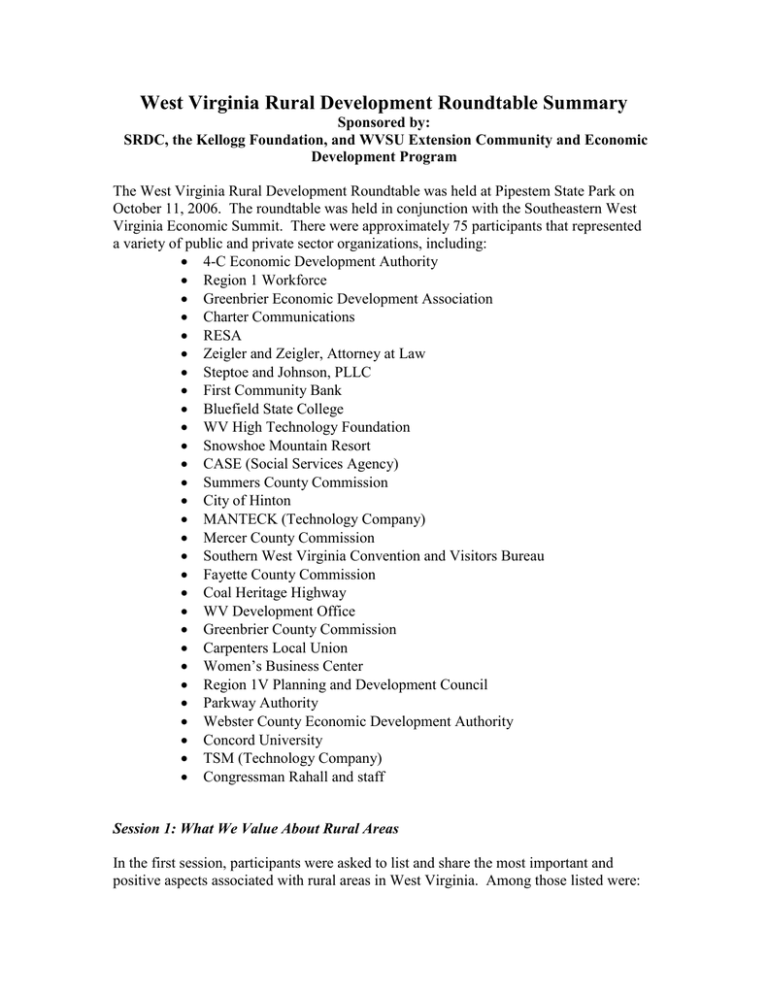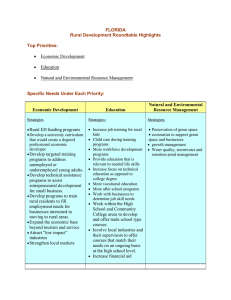West Virginia Rural Development Roundtable Summary
advertisement

West Virginia Rural Development Roundtable Summary Sponsored by: SRDC, the Kellogg Foundation, and WVSU Extension Community and Economic Development Program The West Virginia Rural Development Roundtable was held at Pipestem State Park on October 11, 2006. The roundtable was held in conjunction with the Southeastern West Virginia Economic Summit. There were approximately 75 participants that represented a variety of public and private sector organizations, including: 4-C Economic Development Authority Region 1 Workforce Greenbrier Economic Development Association Charter Communications RESA Zeigler and Zeigler, Attorney at Law Steptoe and Johnson, PLLC First Community Bank Bluefield State College WV High Technology Foundation Snowshoe Mountain Resort CASE (Social Services Agency) Summers County Commission City of Hinton MANTECK (Technology Company) Mercer County Commission Southern West Virginia Convention and Visitors Bureau Fayette County Commission Coal Heritage Highway WV Development Office Greenbrier County Commission Carpenters Local Union Women’s Business Center Region 1V Planning and Development Council Parkway Authority Webster County Economic Development Authority Concord University TSM (Technology Company) Congressman Rahall and staff Session 1: What We Value About Rural Areas In the first session, participants were asked to list and share the most important and positive aspects associated with rural areas in West Virginia. Among those listed were: Quality of life Recreational activities Environment Work Ethic Natural Beauty Easy Access Good People Toughness of People Natural Resources The top ranking positive features about rural areas in West Virginia as agreed upon by the participants were: Small communities Natural Beauty Water Resources Lower cost of living Friendly attitude View Sheds Session 2: Priorities for Strengthening the Future of Rural Areas: In Session two participants were asked to identify the topics that were of the highest priority to promoting the long-term survival and strength of rural areas in West Virginia. The following topics were identified by the participants: Economic Development Education Workforce Development Communication Technologies Leadership, citizen participation and governance Public Service / Public Infrastructure Health and Nutrition Natural and environmental resource management The group then narrowed the individual responses to the following three priority areas: 1. Economic Development: Economic development efforts must be initiated to address the lagging economy of the state. As a whole, the state ranks extremely low in almost every economic indicator, typically either last or no better that the bottom five. This issue is particularly important for the rural areas, as illustrated by 19 of the rural counties being designated by the Appalachian Regional Commission as being distressed economically. These economic challenges are due largely to the changing economies for many of the rural communities, from one heavily dependent on the higher paying extraction (mining, timbering) industries to one which is heavily service related. Lost is the opportunity for entrepreneurial development in the state, where industrial recruitment remains the main thrust of the economic development efforts. An approach that expands beyond this market and begins to target and grow new and different economies is needed. However, participants felt that this economic refocusing must have participation and priority given it from the state through the community level. Issues necessary to the needed economic redevelopment included new tax programs, access to capital, a re-trained workforce and housing. 2. Education/Workforce Development: The loss of industrial and mining jobs has left a large gap of high-paying jobs in many West Virginia rural areas. To enable new economies to be developed in the rural areas, the work-force must be retrained with the technical skills needed by todays workforce. The states workforce is also aging, and experiencing the brain-drain of its youth out-of-state to the more cutting-edge educational programs and to more progressive and better paying states for employment opportunities. To address this, new training programs must be created through a strengthened vocational and community college system. The high school graduate rate, followed by the college going-rate must be improved dramatically. Efforts must be advanced so that West Virginia becomes recognized for having a skilled and available workforce instead of being thought of as being aged and uneducated. 3. Information and Communication Technologies: West Virginia is fairly accessible transportation wise via its interstate system, but has lagged behind many areas on it’s accessibility via the highly critical electronic methods. We have broadband availability in the more populous areas, but still lack fiber to the business sectors and homes in many of the smaller rural communities. Our terrain, lack of funds, lack of education and the availability of services is hindering business and community development efforts that are contingent on having access to technology. Our small population and rural nature is hampering interest by service providers who need adequate demand to justify the expenditure for the broadband infrastructure. Session 3: Digging Deeper into the Three Priority Areas: Session three provided a more comprehensive review of the three rural development priority areas identified by the participants. Each participant was asked to respond to the following two questions for each priority area: (1) What specific challenges are rural areas in your state facing right now with regard to the topic? (2) What strategies or initiatives should be launched to help rural communities in your state as it relates to this priority area? 1. Economic Development Challenges: Finance – lack of capital for start-up or business expansion Transportation – good interstate system but poorer rural system Development of alternative economies to replace declining industries Lack of organized partnerships among public and private funding sources Under skilled workforce – poor college graduation rate; not skilled in newer fields Burdensome tax structures and rates Poor community based planning Lack of leadership development skills Out-migration of younger work-force Strategies/Initiatives to be launched: Facilitate opportunities for regional cooperation Research and advise on possible state incentive programs Work to develop / strengthen small business cooperatives Work to develop new business opportunities such as specialty crops/valueadded opportunities, hospitality, artisans, etc. Develop and deliver programs that foster small business development Work to facilitate access to capital program, including alternative financing options Provide rural communities with strategic assessments on economic alternatives and growth opportunities Work with communities to enhance image and identify niches Provide community planning assistance Provide community leadership training 2. Education and Workforce Development Challenges: Poor High school completion rate Poor two and four-year college graduation rates Developing community college system Under-funded educational programs Poor participation in math and science Higher Education primarily focused on liberal arts High rate of substance abuse usage Aging population of workforce Strategies/Initiatives to be launched: Expand the availability of distance learning and collaborative education Strengthen relationship between secondary and post-secondary education Strengthen relationship between vocational and secondary education Foster less competitive environment among the higher education system by rewarding collaboration Support delivery of additional substance abuse education efforts Youth based business development programming expanded Entrepreneurship taught at all levels of education Sponsorship of science and math camps 3. Information and Communication Technology Challenges Remote areas do not even have access to dial-up Services are sporadic even in more populated areas Services rates are perceived to be “too-high” Citizenry doesn’t understand the full usage of technology Businesses don’t understand the full capability of technology nor how to access markets Small size of many communities make it cost prohibitive for the roll-out of traditional fiber options Small size of communities limits the competitive interest in developing areas The terrain makes alternatives to ground-laid fiber difficult Strategies and Initiatives to be launched: Work with communities to collaborate so as to develop greater demand Work with citizenry to provide educational programs on the need for technology so as to increase the demand Develop small business training programs to increase the utilization of technology, resulting in enhanced operational ability as well as increasing demand for services so that the suppliers will support the roll-out Work with communities to explore alternative delivery mechanisms such as wire-less Work with communities to develop funding sources to assist with the financing of the technologies


